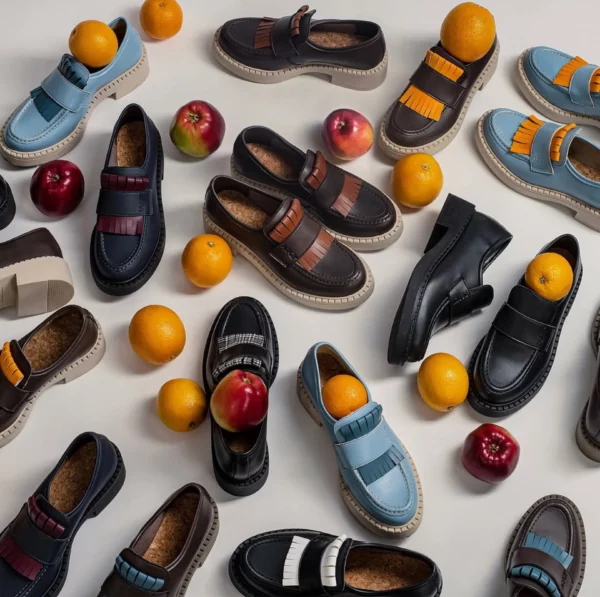Fashion isn’t just about looking good anymore; it’s about meaning, innovation, and responsibility. Enter 2025, a year that’s redefining what we wear and why we wear it. Whether you’re a global buyer, supplier, or fashion enthusiast, understanding the latest trends is key to staying ahead. This evolution is fueled by innovative materials, a celebration of cultural heritage, and a commitment to sustainability.
1. The Power of Innovative Materials
The fashion industry is at the forefront of material innovation, with groundbreaking textiles pushing the boundaries of creativity and ethics. Designers are adopting bio-based materials, steering away from resource-intensive fabrics like traditional leather and polyester.
Plant-Based Leathers Steal the Spotlight
One notable example is Piñatex, derived from pineapple leaves, making waves in vegan fashion. Piñatex offers a sustainable alternative to animal leather while creating additional revenue streams for subsistence farmers. This leather substitute is being widely used in shoes, bags, and accessories and adored for its durability and low environmental impact.
Similarly, Orange Fiber, made from citrus juice byproducts, is transforming waste into stunning TENCEL™ fabrics. It’s a shining example of circular fashion, blending innovation with a softer environmental footprint.

Bio-Plastics from Potato Waste
Bio-plastics are also entering the fashion realm. Chip[s] Board uses industrial potato waste to create translucent, recyclable bio-plastics ideal for apparel and accessories. These materials mimic conventional plastics but with significantly less harm to the planet.
2. A Tribute to Cultural and Heritage-Driven Fashion
Fashion has always been a reflection of culture and history, but in 2025, it goes deeper. Designers are embedding cultural narratives into modern designs, bridging the gap between past and present.
Boho-Chic Reinvented
Bohemian-inspired styles dominated the Spring 2025 runways according to Glamour. Sheer layers, handicraft details, and rich embroidery are being paired with modern silhouettes. Valentino and Fendi led the charge, blending vintage aesthetics with contemporary fashion.
Cultural Prints from Around the World
Cultural prints and traditional fabrics like batik, ikat, and handwoven textiles take center stage, originating from communities in Asia, Africa, and South America. These garments not only look incredible but also help support artisan economies and preserve dying crafts.
By choosing cultural and heritage-based designs, 2025’s fashionistas are also weaving stories and values into their wardrobes.

3. Sustainability is Not a Trend — It’s the Standard
Sustainability is no longer optional; it’s the baseline for fashion in 2025. Ethical practices and conscious consumerism have reshaped purchasing decisions.
A Demand for Circular Fashion
Circular economy practices have surged. Over 70% of consumers consider a brand’s environmental impact before buying according to HKTDC Research. Companies now focus on producing garments that can be recycled or repurposed at the end of their lifecycle. Brands like Orange Fiber and Chip[s] Board are pioneering this space, leading by example.
Emphasizing durability and reduced waste, these textiles support a circular economy, appealing to consumers who value sustainability and conscious fashion choices without compromising on style or quality.
Moving Forward with Fashion in 2025
Fashion has entered an era of innovation and consciousness like never before. The trends of 2025 redefine what it means to dress well, intertwining aesthetics with ethics.
The use of innovative materials, a strong nod to cultural heritage, and a firm commitment to sustainability will guide the industry’s future. By leveraging these insights, you can shape your business and personal style to align with the next big wave of fashion.
Register for Fashion InStyle and join the conversation on the future of fashion! Happening from 27 – 30 April, you will witness the above trendsetters and be part of the gamechangers that embrace Sustainable Denim, Functional Fabric, among many other innovative materials and garments.
Simply click through the banner below to reserve your spot:
Continue your fashion sourcing on our e-Marketplace too!
Fashion Fair FAQ
What Fashion Trends Should We Pay Attention to This Year?
Innovative materials such as functional fabrics and eco-friendly textiles will be the spotlights in 2025. There is also an increased tendency to use cultural and heritage elements in fashion design.
Why Joining Fashion InStyle?
By joining the fashion event physically, not only you can network with fellow fashionistas and peers, but also explore the craftsmanship and human touch in-person.
Related posts:
 International Buyer Sourcing Behaviour Survey 2025: Strategic Sourcing in Uncertain Times (Part 2)
International Buyer Sourcing Behaviour Survey 2025: Strategic Sourcing in Uncertain Times (Part 2)
 Jewellery Shows Exhibitors Dazzle: From Showcase to Success
Jewellery Shows Exhibitors Dazzle: From Showcase to Success
 Global Homeware Trends 2025: The Definitive Sourcing Guide
Global Homeware Trends 2025: The Definitive Sourcing Guide
 The State of Fashion 2024-25: Embracing Sustainability, Diversity, and Global Opportunities
The State of Fashion 2024-25: Embracing Sustainability, Diversity, and Global Opportunities

















